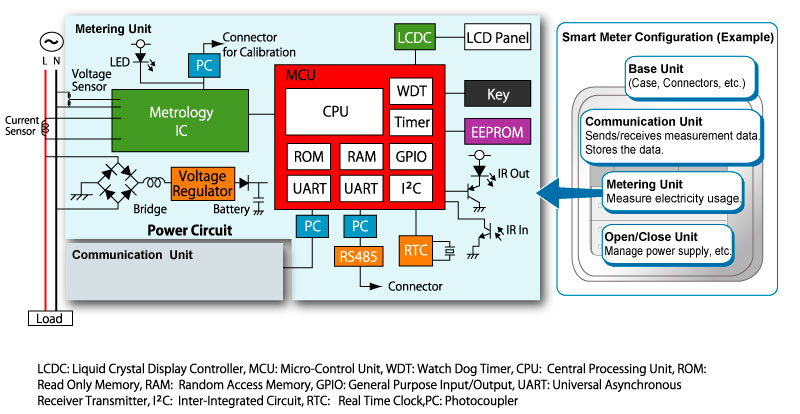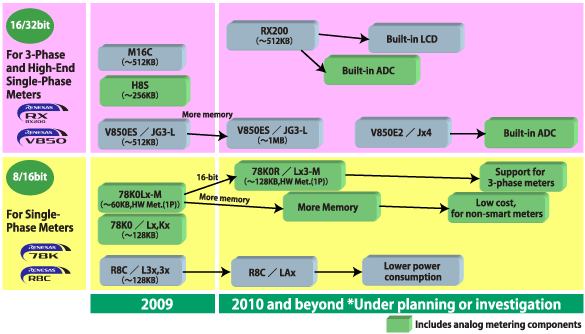Smart meters are key parts of the smart-grid power-distribution networks now being rolled out internationally to achieve economic and environmental benefits. Traditional energy meters are mechanical, but smart meters must be electronic, so this type of product represents a major new global mass market for semiconductor devices. The two key design requirements for smart meters are (1) they should operate at low energy so they can run for prolonged periods on battery power, and (2) they must include security features that can protect the content of communications and the safety of stored data. In this article we discuss trends and issues in smart-meter development, and then describe some of the solutions that Renesas brings to this expanding market.
Emerging application goals define additional requirements for smart meters
As more smart grids come on line around the world, smart meters are becoming increasingly common for measuring residential electricity consumption. Like a traditional mechanical meter, a smart meter records power usage; but unlike it, a smart meter typically also includes communication capabilities essential to the ‘intelligence’ of the smart grid. Moreover, whereas the old-style energy meters are mechanical, smart meters have to be electronic. Therefore, these devices are establishing a huge new global market for semiconductor devices, particularly microcontrollers.
The two initial development goals for smart meters were to implement power-usage monitoring that would prevent utility theft, and to enable the remote reading of usage data that would improve the operating efficiency of the utility company. However, now three new goals are emerging, as well. Specifically, they are (1) to encourage energy conservation by presenting customers with vivid pictures of historical and real-time energy usage; (2) to create an information base essential to the construction of smart grids that utilize distributed power sources; and (3) to comprehensively assess power-demand conditions so that utility companies can take steps to forestall outages.
Detailing the key parts of smart meters
Generally, a smart meter consists of three elements or units: a metering unit, a communication unit, and an open/close unit (see block diagram in Figure 1). The metering unit tracks the customer’s utility usage and processes the billing. The communication unit enables two-way digital communication with the utility company. The start/stop unit starts and shuts down the utility supply.
In an electronic power meter, the metering unit consists of a metering section that measures the current and voltage; a microcontroller section that calculates power usage and billing data based on these measurements; a display section that shows status and other information; and an EEPROM section that stores billing data. There is also a photo-coupler that provides line isolation, while interconnecting with the communication unit that transmits and receives data and commands.

Block diagram of the metering unit for a typical smart-type electricity meter (here, a single-phase, two-wire design).
Creating meter designs that meet the varied needs of localities and utilities
Being a leading international semiconductor technology company, Renesas is committed to meeting the needs of makers of smart meters around the globe. Because development goals for these devices vary according to region and utility company, our engineers currently are working on three different internal configurations. The optimum sets of microcontroller specifications and capabilities differ significantly among these three types of smart-meter configurations.
In the first type of configuration, the microcontroller is used only for utility-bill processing. Because heavy-duty calculating power isn’t required, a low-cost device with an 8-bit architecture is sufficient. Further, the energy used by the electronics can be reduced by carrying out most of the processing at the hardware level. Memory requirements are also modest, and the overall cost of the design is quite low. Another advantage of this configuration is that product development is fairly rapid, since there isn’t any need to develop metering capabilities. This last advantage is particularly significant for the Chinese market, in which there is a strong incentive to reduce development times.
The second type of configuration includes software for calculating power usage. Thus, the system design requires a fast microcontroller, generally a device with a 16-bit architecture. Such smart meters are more versatile than more basic type described previously. They are particularly appropriate for markets such as India, where many local programmers are available for developing the requisite software.
The third type of smart-meter configuration is the most complex and capable. It requires a microcontroller equipped with an analog-to-digital converter (A/D) port that enables sensing/measuring power usage. It uses software to carry out diverse data-processing functions―including digital filter processing, power usage calculations, and processing of a customer’s energy costs. This configuration type is very flexible and can be provided with software to serve either residential single-phase power or industrial three-phase power. Because it must deliver high processing performance, however, this configuration type requires the use of a 32-bit microcontroller with digital signal processing (DSP) capability and other such features. The emphasis here is on development efficiency. Demand for this high-end smart-meter configuration is high in those areas of the world in which utility companies are focused on providing added services, such as in the U.S and Europe.
Offering microcontrollers that meet diverse system requirements
Renesas provides a full lineup of microcontrollers to meet the different design requirements of all three types of smart-meter configurations. This, we support many different applications for a wide range of customers. For the basic, type-1 configuration meter designs for example, we recommend the economical chips in the R8C family, as well as our 78K0 devices, which integrate a power-calculation unit for single-phase power. For the more-capable type-2 and most-capable type-3 configurations, we currently offer the microcontrollers in our 78K0R, V850, and H8S families. Moreover, this lineup soon will be augmented by chips in the RX200 family, among others (see the roadmap in Figure 2).
To meet customer requests, Renesas is fully prepared to deliver not just chips for smart meters, but comprehensive solutions, too. Our tailored system designs can include not only microcontrollers, but also current/voltage metering sections, display sections, EEPROM (for storing billing data), and other types of support ICs, as well as reliable power devices (MOSFETs, etc.). Requests for quotes (RFQs) are encouraged.

Roadmap for Renesas microcontrollers for smart meters.
Providing standardized products and ASICs for communications units
Two major types of communication units are used in smart meters. The first type transmits information over a neighborhood area network (NAN) and is mainly used to send billing information to the utility company. The other type communicates over a home area network (HAN) and enables the smart meter to serve as a gateway into the networked electronic systems in a home.
NAN implementations vary by region: some are wireless, while others communicate over the power lines. For example, the US mainly employs mesh communication over a 900-MHz bandwidth, while China and Europe generally use power-line communication. Japan generally uses wireless communication, although there is an ongoing investigation into specified low-power, 950-MHz, and PHS implementations. HAN implementations, by contrast, typically use wireless links (WiFi, ZigBee, 6LoWPAN, or Z-Wave); otherwise, HANs use a wired link (Ethernet).
This communication-protocol diversity means that the semiconductors required to implement communication units vary according to the region in which the smart meter will be used and the requirements of the utility company. For that reason, Renesas is currently developing a variety of IP cores for standardized products―including cores for wireless communication on the sub-GHz band, and cores with multi-modem capabilities.
Additionally, we plan to offer ASIC solutions for communication units. Our vast semiconductor production facilities can deliver custom products within a short period of time that are fine-tuned to meet a customer’s exact communication specifications. ASIC development at Renesas is based on cutting-edge IC manufacturing processes that fully support low-power-consumption implementations. Again, RFQs are encouraged.
Delivering hardware encryption engines and anti-tampering features that ensure secure, worry-free operation
The incorporation of a communication capability within a meter creates some risks―most particularly, the risk of attacks by hackers. In the worst case, such an attack might cut the lifeline of a utility’s metering system, crippling its power distribution infrastructure and thus causing a catastrophe. To reduce the huge potential danger entailed by this type of situation, communications must be encrypted.
In particular, two types of data protection are probably required. First, high-level encryption should be implemented―at the router level, for example―to block remote hacking attempts. Second, anti-tampering features are necessary to ensure that any hackers who get direct access to the meter itself will not be able to steal confidential information from the smart meter’s microcontroller section.
Renesas already has developed, implemented and proven the essential security technologies, including a high-level hardware encryption engine and a high-level anti-tampering capability. This achievement, we believe, gives us an important technological and production edge over other IC makers. Our current plan is to offer NAN devices utilizing these technologies to deliver the robust security features mandated by our customers.
Peripheral devices essential for smart meters are also available from Renesas, devices such as EEPROM chips and photocouplers. We can be a ‘one-stop shop’ for the entire semiconductor bill-of-materials (BOM), simplifying parts procurement. That capability, coupled with our comprehensive suite of hardware/software development tools, helps customers accelerate their development processes and facilitates volume meter production.
Looking ahead, anticipating future needs for smart-meter designs
Renesas is committed to funding an ongoing series of R&D programs in support of this vital, rapidly growing segment of the electronics market. Our technology investments aim to ensure that we will continue to deliver the advanced semiconductor solutions essential for meeting the rising demand for the smart meters essential for building smart grid infrastructures around the world.
Advertisement
Learn more about Renesas Electronics America





